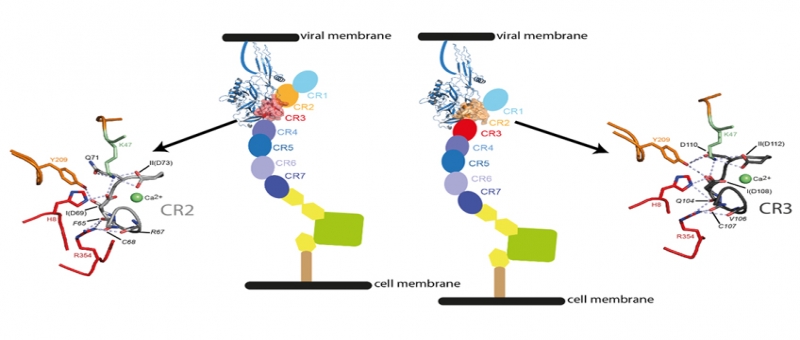Vesicular stomatitis virus (VSV) is an enveloped virus which can infect insects, cattle, horses, and pigs. In mammals, its ability to infect and kill tumor cells, although sparing normal cells, makes it a promising oncolytic virus for the treatment of cancer. Its membrane contains a unique glycoprotein (G) that plays a major role in the early stages of infection.
Researchers from the I2BC Virology Department and the PROXIMA-1 beamline have obtained new 3D protein structures of G in complex with two domains of a VSV receptor.
First, the G glycoprotein recognizes the receptors at the host cell surface and then, after endocytosis, it catalyzes the fusion of the viral and endosomal membranes, which allows the release of the viral nucleocapsid in the cytosol for the subsequent stages of the viral infection.
The Low-Density Lipoprotein1 receptor (LDL-R) and other members of its family had been proposed to be VSV receptors. Researchers from the I2BC Virology Department and the SOLEIL synchrotron have just obtained two new structures of G in complex with two independent CR (for Cystein Rich) domains of the LDL-R (which contains seven CR domains in its ligand binding domain). Both CR domains occupy the same binding site on G. Two residues of G essential for the binding of CR domains were identified and their mutation abolishes the ability of G to bind its receptor without affecting its viral fusion properties. Remarkably, viruses pseudotyped2 with such G mutants are no longer infectious. This work shows that G has evolved to specifically recognize the CR domains encountered in members of the LDL-R family and that the only viral receptors belong to this family.
As VSV is an oncolytic virus and G is the most used glycoprotein for vectorization, this work opens many perspectives in medical biotechnology. Indeed, the possibility of decoupling the recognition of the receptor and the viral fusion properties makes it possible to envisage the construction of glycoproteins targeting other receptors. This might be used to pseudotype retroviruses or to construct VSVs fully retargeted to specific cells of interest.

Figure: Drawing showing the interaction between VSV G and the LDL-R when proteins are anchored in their respective membranes. Right and left: Close-up on the X-ray structures of VSV G in complex with CR2 (on the left) and CR3 (on the right) allowing the identification of residues that are crucial for the virus/receptor interaction.
1 - Low-Density Lipoproteins (LDL): proteins which deliver fat molecules –notably cholesterol- to the cells
2 – Pseudotyped virus: a virus in combination with foreign viral envelope proteins, used to alter host tropism or an increased/decreased stability of the virus particles.
